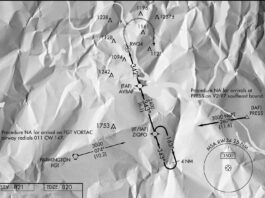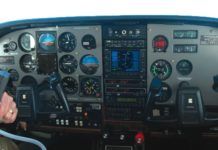How to fly an ILS without an ILS
If youve ever seen the dramatic final scene of Strategic Air Command with Jimmy Stewart, youve seen a Precision Approach Radar, or PAR, approach. A PAR begins with vector- to-course, much like an ILS, but also adding trend info to help the pilot build situational awareness.
Wind on the ILS
Youre descending on the glideslope for the ILS 29 with a 25-knot tailwind. Winds at the surface are eight knots from the southwest. Quick: What two corrective actions will you need to make over the next three minutes? With enough experience youll get it right, but ask yourself: Is this brand of analysis second nature to you? Sure, you can just follow the needles and correct, but thats accepting being behind the curve rather than mastering it. An understanding of the variables affecting an approach path give you the capacity for proactive, rather than reactive, piloting.
Readback: May 2010
On page 14 of the February issue (Glass Panel Scans), you state that a case can be made for flying track instead of a heading assigned by ATC. This I have to hear. When a controller assigns me a heading, that is what he wants me to do, and doing something else would seem to constitute failure to follow an ATC instruction. Your thoughts?
Readback: April 2015
I see a lot of confusion between the terms VFR and VMC (as well as IFR and IMC). VMC and VFR are often used interchangeably, in fact.To me, VFR and VMC are in fact not the same because VFR refers to a set of rules that govern flight (visual flight rules), which includes airspace and so on. There are certain weather minimums to operate VFR. However, VMC can be interpreted as conditions that allow you to keep the plane upright by looking outside. You can be VMC but in VFR weather by simply being 1500 feet away from a cloud.However, while I could find VFR and IFR defined in FAR/AIM, I couldnt find anything for VMC. Are you aware of any FAA guidance on this?
IFR Gone Good
I recently had a beautiful IMC flight on which I relearned how wonderful our capability to operate in the IMC world is. Its easy to lose that awe for the beauty of our environment and the utility of the machines at our disposal as we move safely through this environment. Such is the stuff of poets. So this is not a story of drama over bad weather, near misses or close calls. Its a story of the unique advantage and perspective that the few humans who call themselves pilot have been able to experience and enjoy.
Silent Running
Part of training in the air traffic control profession is learning to recognize patterns in the flow of aircraft. Knowing what to expect from our traffic makes it all the more obvious when something doesnt look or feel right. Its not a spidey-sense or anything, but it can help us recognize developing situations more quickly.
Calling For Help
Flight is a study in contrasts, well beyond the obvious thrust versus drag equation. A brilliant blue sky rife with possibilities and adventure can quickly turn woefully lonely when your aircraft or the people in it are in distress. No good pilot intends for an emergency to happen. Each item on an aircraft checklist, every scan of an instrument and every word of a briefing is one more brick in the wall fending off a potential crisis. Still, even if you followed every procedure perfectly, basic human error, mechanical failure or plain bad luck can plunk you in the deep end of the pool.When youre in the midst of a devolving situation, perhaps youll hear mental echoes of your flight instructors voice. Rely on your training. Go through your checklists. Keep a cool head and resolve the problem to the best of your ability. Whats the most important thing after flying the airplane? Remembering youre not alone up there. Air traffic control has resources at its disposal that can help you put it down safely, and theyre just a radio call away.
Bag of Tricks
Teaching teaches the teacher. Ive got over 4000 hours total time and of that over 3000 hours teaching instruments. In that time, my students have taught me quite a bit and Ive picked up a few tricks on my own. Heres a compendium of helpful little tips and tricks.
How Old is Too Old?
Many times Ive mentioned that my day job is flying airliners. With flying as a second career for me after 30 years in the computer industry, Im often asked how long I intend to fly. My flip answer has always been, Until I bust a sim check, line check or medical, or until the company pisses me off one too many times. I never thought to add, Until I age out.Im reaching that numerical age where yesterday, according to the FAA, I was suitable to hold responsibility for all those lives in my-thus far-capable hands, but tomorrow I am not. This barrier has caused me a lot of reflection.
Readback: March 2015
Have any other nitpickers written about the illustration on page 15 of your November 2014 issue accompanying the Simulators Are Not Airplanes sidebar? The author of the very good article writes about how we developed our own VOR approach to a carrier in San Francisco Bay. And the illustration shows a small plane at 200 feet and 75 knots airspeed, headed straight for a carrier deck, apparently on final approach.
Read Beside The Lines
Harvey Field in western Washington State (S43) is one of those almost mythical GA wonderlands. Cloth-clad antiques trundle down a runway that requires mowing while skydivers pack a careworn Caravan for just one more jump. Views of both can be enjoyed from the windows of on-field caf. At least, thats the way it used to be. Its been a while since Ive had the pleasure. Since Ive frequented the field, Harvey has also stepped into the digital age with its own GPS approach. But like the fuel gauges on my buddy Daves Harvey-based Globe Swift, its an imprecise thing. In fact, its a downright odd-looking approach for something starting with the letters RNAV-which should be a clue to anyone flying it that theres probably more going on here than meets the eye. Perhaps literally.
What it Takes to Type
Make no mistake about it: Going through a two- to three-week type-rating course is grueling. Many pilots have a strong preference for turboprop aircraft for the explicit reason that no type rating is required. But like the process of flying jets itself, the type course is structured; a specific set of steps impart a specific knowledge to the pilot. The information that must be learned is clear and finite for a type rating. Unfortunately, finite doesnt mean small.














